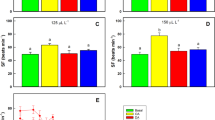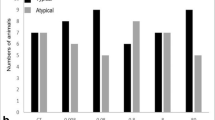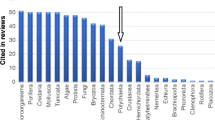Abstract
Tissue and extractable metabolites from the subtropical gorgonianLeptogorgia virgulata (Coelenterata: Anthozoa: Octocorallia: Gorgonacea) induce vomiting in a variety of fish species. To elucidate the chemical bases of this phenomenon, experiments were undertaken with purified pukalide, a cembranoid diterpene that comprises as much as 0.1–0.5% of the wet tissue weight ofL. virgulata. When incorporated into artificial foods at concentrations corresponding to the levels found inL. virgulata, pukalide induced emesis when delivered orally to killifish (Fundulus heteroclitus). The threshold dose for pukalide-induced emesis was 0.05 mg/g fish body weight. Control pellets devoid of pukalide did not induce vomiting. The emetic effect of pukalide was dose-dependent, as fish ingesting more than 0.100 mg pukalide/ g body weight exhibited a significantly higher incidence of vomiting than fish ingesting lower doses of pukalide (G=5.5,df=1,P<0.025). The elapsed time between ingestion of pukalide-containing pellets and emesis was significantly longer in fish that ingested marginally emetic doses of pukalide (Kruskal-WallisH=4.00, significant withP<0.05). Although not markedly unpalatable to fish, pukalide may function in nature as a defensive toxin by inducing emesis and learned aversion in potential octocoral predators.
Similar content being viewed by others
References
Bakus, G.J., Targett, N.M., andSchulte, B. 1988. Marine chemical ecology: An overview.J. Chem. Ecol. 12:951–987.
Bayer. 1961. Shallow-Water Octocorallia of the West Indian Region. Studies on the Fauna of Curacao, Volume 69. Martinus Nijhoff, The Hague.
Brower, L.P. 1984. Chemical defence in butterflies.Symp. R. Entomol. Soc. London 11:109–134.
Cohen, P., Holmes, C.F.B., andTsukitani, Y. 1990. Okadaic acid: A new probe for the study of cellular regulation.Trends Biochem. Sci. 15:98–102.
Coll, J.C. 1992. The chemistry and chemical ecology of octocorals (Coelenterata, Anthozoa, Octocorallia).Chem. Rev. 90:613–631.
Coll, J.C., Bowden, B.F., Heaton, A., Scheuer, P.J., Li, M.K.W., Clardy, J., Schulte, G.K., andFiner-Moore, J. 1989. Structures and possible functions of epoxypukalide and pukalide: Diterpenes associated with eggs of sinularian soft corals (Cnidaria, Anthozoa, Octocorallia, Alcyonacea, Alcyoniidae).J. Chem. Ecol. 15:1177–1191.
Faulkner, D.J. 1984. Marine natural products: Metabolites of marine invertebrates.Nat. Prod. Rep. 1:551–598.
Fenical, W., Okuda, R.K., Bandurraga, M.M., Culver, P., andJacobs, R.S. 1981. Lophotoxin: A novel neuromuscular toxin from Pacific sea whips of the genusLophogorgia.Science 212:1512–1524.
Gerhart, D.J. 1984. Prostaglandin A2: An agent of chemical defense in the Caribbean gorgonianPlexaura homomalla.Mar. Ecol. Progr. Ser. 19:181–187.
Gerhart, D.J. 1991. Emesis, learned aversion, and chemical defense in octocorals: A central role for prostaglandins?Am. J. Physiol. 260:R839-R843.
Gerhart, D.J., Rittschof, D., andMayo, S.J. 1988. Chemical ecology and the search for marine antifoulants: Studies of a predator-prey symbiosis.J. Chem. Ecol. 14:1905–1917.
Ksebati, M.B., Ciereszko, L.S., andSchmitz, F.J. 1984. 11B,12B-Epoxypukalide, a furanocembranolide from the gorgonianLeptogorgia setacea.J. Nat. Prod. 47:1009–1012.
Missakian, M.G., Burreson, B.J., andScheuer, P.J. 1975. Pukalide, a furanocembranolide from the soft coralSinularia abrupta.Tetrahedron 31:2513–2515.
Patton, W.K. 1972. Studies on the animal symbionts of the gorgonian coralLeptogorgia virgulata (Lamarck).Bull. Mar. Sci. 22:419–431.
Paul, V.J. (ed.). 1992. Ecological Roles of Marine Natural Products. Comstock Press, Ithaca, New York.
Rittschof, D., Hooper, I.R., Branscomb, E.S., andCostlow, J.D. 1984. Inhibition of barnacle settlement and behavior by natural products from whip corals,Leptogorgia virgulata (Lamarck, 1815).J. Chem. Ecol. 11:551–563.
Scheuer, P.J. 1990. Some marine ecological phenomena: Chemical basis and biomedical potential.Science 248:173–177.
Standing, J., Hooper, I.R., andCostlow, J.D. 1982. Inhibition and induction of barnacle settlement by natural products present in octocorals.J. Chem. Ecol. 10:823–832.
Tursch, B. 1982. Chemical protection of a fish (Abudefduf leucogaster Blacker) by a soft coral (Litophyton viridis May).J. Chem. Ecol. 8:1421–1428.
Tursch, B., Braekman, J.C., Daloze, D., andKaisin, M. 1978. Terpenoids from coelenterates, pp. 247–291,in P.J. Scheuer (ed.). Marine Natural Products, Vol. II. Academic Press, New York.
Vrolijk, N.H. 1992. Biotransformation enzymes in marine organisms: Implications for detoxification of dietary allelochemicals. Doctoral dissertation. University of Delaware (Marine Studies), Lewes, Delaware.
Author information
Authors and Affiliations
Rights and permissions
About this article
Cite this article
Gerhart, D.J., Coll, J.C. Pukalide, a widely distributed octocoral diterpenoid, induces vomiting in fish. J Chem Ecol 19, 2697–2704 (1993). https://doi.org/10.1007/BF00980701
Received:
Accepted:
Issue Date:
DOI: https://doi.org/10.1007/BF00980701




